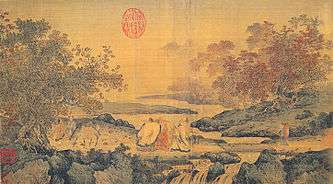Three laughs at Tiger Brook

Three laughs at Tiger Brook (Chinese: 虎溪三笑 ; Pinyin: hǔ xī sān xiào ; Gan: fû ki sam siēu) is a Chinese proverb which refers to the image that the three men, Huiyuan, Tao Yuanming and Lu Xiujing laugh together when arriving at Fuki (虎溪, Tiger Brook) of Mount Lu. This concept represents the ideal harmonious relations of Confucianism, Taoism and Buddhism in ancient China.
Origin
The proverb came from the story of the recluse monk Huiyuan (334–416) who never used to go farther than Fuki, even for a walk or a friend's visit. Moreover, the tiger hiding in the forest would roar to warn him once he crossed the brook. One day, on the visit of the poet Tao Yuanming (365–427) and Taoist Lu Xiujing (406–477), Huiyuan had a congenial talk with them. As a result, they only realized they had passed the brook when they heard the roar of the tiger. They laughed wisely together, which represents the desired relationship among the three main religions/philosophies of that time, namely the harmony among Confucianism, Taoism and Buddhism.
This story began as early as the Tang Dynasty and became popular during the Song Dynasty. It's proved to be impracticable as Lu Xiujing had a visible age difference from the other two.